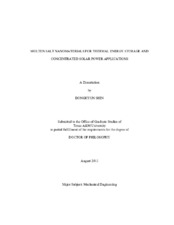| dc.description.abstract | The thermal efficiency of concentrated solar power (CSP) system depends on the maximum operating temperature of the system which is determined by the operating temperature of the TES device. Organic materials (such as synthetic oil, fatty acid, or paraffin wax) are typically used for TES. This limits the operating temperature of CSP units to below 400 degrees C. Increasing the operating temperature to 560 degrees C (i.e., the creeping temperature of stainless steel), can enhance the theoretical thermal efficiency from 54 percent to 63 percent. However, very few thermal storage materials are compatible for these high temperatures.
Molten salts are thermally stable up to 600 degrees C and beyond. Using the molten salts as the TES materials confers several benefits, which include: (1) Higher operating temperature can significantly increase the overall cycle efficiency and resulting costs of power production. (2) Low cost of the molten salt materials can drastically reduce the cost. (3) The molten salts, which are environmentally safe, can also reduce the potential environmental impact. However, these materials suffer from poor thermo-physical properties. Impregnating these materials with nanoparticles can enhance these properties. Solvents doped with nanoparticles are termed as nanofluids. Nanofluids have been reported in the literature for the anomalous enhancement of their thermo-physical properties. In this study, the poor thermal properties of the molten salts were enhanced dramatically on mixing with nanoparticles. For example the specific heat capacity of these molten salt eutectics was found to be enhanced by as much as ~ 26 percent on mixing with nanoparticles at a mass fraction of ~ 1 percent. The resultant properties of these nanomaterials were found to be highly sensitive to small variations in the synthesis protocols.
Computational models were also developed in this study to explore the fundamental transport mechanisms on the molecular scale for elucidating the anomalous enhancements in the thermo-physical properties that were measured in these experiments.
This study is applicable for thermal energy storage systems utilized for other energy conversion technologies – such as geothermal energy, nuclear energy and a combination of energy generation technologies. | en |


